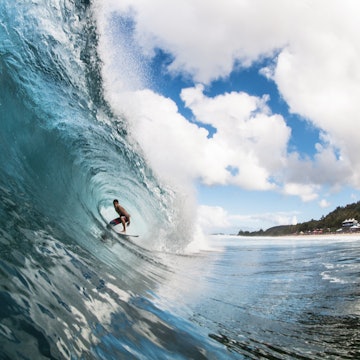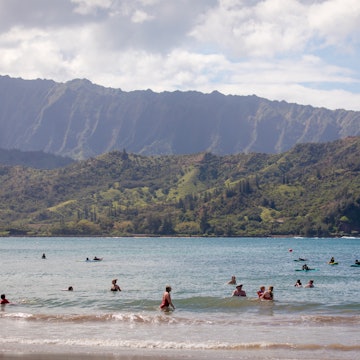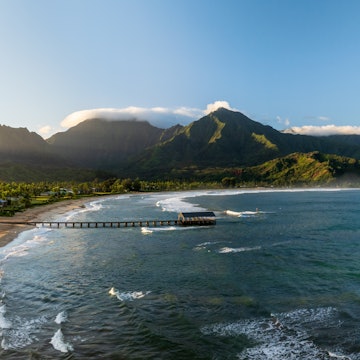
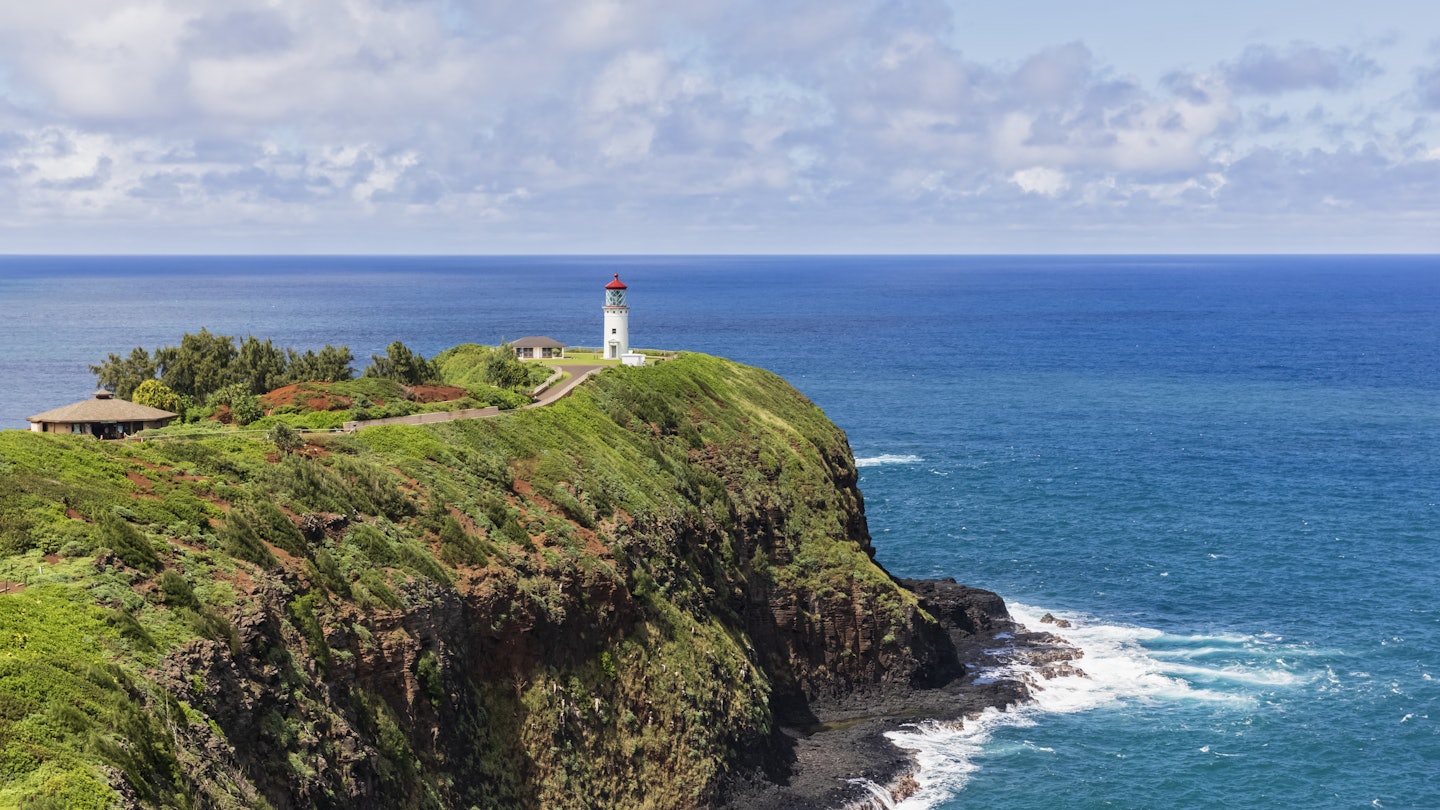
From some of the world’s best beaches to lively farmers markets, there’s a lot to experience in Kauaʻi that doesn't cost a cent © Westend61 / Getty Images
Don’t let the median cost of a single-family home ($1 million) or the price of gas (nearly $5 a gallon) in Hawaii scare you: You don’t have to spend a lot to have a great time in the Islands, Kauaʻi included.
From some of the world’s best beaches to lively farmers markets, there’s a lot you can do and experience without spending a cent. Here’s our guide to the best free things to do on the Garden Isle.
Stroll along the eastern shoreline
Ke Ala Hele Makalae is a miles-long coastal path that runs from Lydgate Beach Park to secluded Kuna Bay (aka Donkey Beach) on the island’s east side. While many people hop on bikes – there are rental shops in Kapaʻa town – the trail is easily walked too.
The paved path, which will eventually run for 17 miles when complete, follows a former railroad line once used to haul sugarcane. Spend the day at the beach, which boasts two calm lagoons perfect for swimming and snorkeling, then stroll along the coastal path. There are interpretative signs along the way, pointing out local archeological, cultural and historic sites, as well as the plants and animals in the area. If you’re lucky, you might spy endangered Hawaiian monk seals lounging on the beach or migrating humpback whales in the winter.
Browse a farmers market
One of the best ways to get to know a place is by visiting its farmers markets, and Kauaʻi has some of the best in the state. There are outdoor markets from Hanalei to Poʻipu, many of them in gorgeous settings.
The Waipa Farmers Market in Hanalei (Tuesdays, 3pm to dusk) features a nice variety of local and organic produce, freshly baked pies and taro chips in scenic Waipa. The nearby Hanalei Farmers Market (Saturdays, 10 to 11:30am), run by nonprofit Hale Halawai ʻOhana o Hanalei, is one of the island’s most popular, with local produce, honey, freshly baked goods and locally made crafts. You can even take part in a yoga class (donations suggested).
In Poʻipu, visit the Kauaʻi Culinary Market (Wednesdays, 3:30 to 6pm) at the Kukuiʻula Shopping Village with locally grown fruits and veggies, honey, jam, goat cheese and the island’s famous sugarloaf pineapples.
In Līhuʻe, the Kauaʻi Community Market (Saturdays, 9:30am to 1pm) at Kauaʻi Community College. Vendors are vetted by the Kauaʻi County Farm Bureau, and the market boasts more than 100 vendors offering everything from Kauaʻi-grown produce to grab-and-go meals made with local ingredients. It often features cooking demos and entertainment too. At any of these farmers markets, look for “Kauaʻi Grown” or “Kauaʻi Made” logos to ensure you’re truly buying local, and bring cash and your own shopping bag.
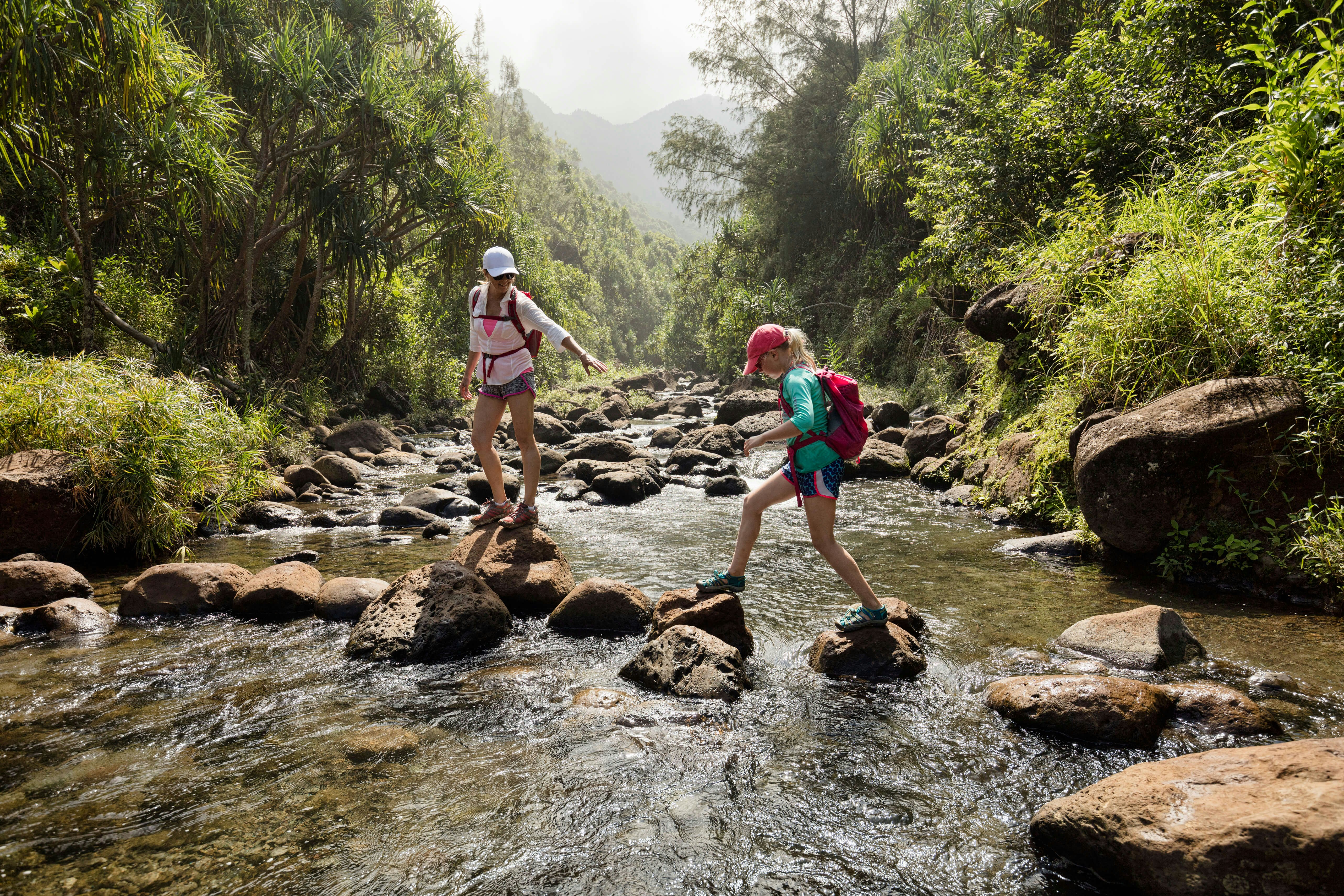
Go for a hike
Kauaʻi has dozens of great hiking trails for all skill levels. Some – like Awaʻawapuhi in Kokeʻe State Park and the famed Kalalau Trail in Haʻena State Park – now require entry fees. (In fact, as of 2020, it's $5 per person and $10 to park just to view Waimea Canyon from the overlook at Waimea Canyon State Park.) But most other trails, including the popular Nounou Mountain (aka Sleeping Giant) and family-friendly Kuilau Ridge Trail (both in Kapaʻa), are free.
Visit a limestone cave
Kauaʻi is home to the largest open-ceiling limestone cave in Hawaiʻi, and you can visit it for free. But it will take a little effort. The easiest – and, in our opinion, best – way to get to Makauwahi Cave is by walking along the scenic 4-mile Mahaʻulepu Heritage Trail along the island’s southern coastline.
The trail starts at Keoneloa Beach (aka Shipwreck Beach) and traverses the shoreline. After about 2 miles – just after the CJM Country Stables – there’s a small opening to enter the cave, which features native plants and fossils. The nonprofit Makuawahi Cave Reserve offers free guided tours from 10am to 4pm daily, though donations are welcome.
Learn about Kauaʻi-grown coffee
With more than 4 million coffee trees growing on 3100 acres, Kauaʻi Coffee Company is the largest coffee farm in the US. The company offers a guided tour at $25 per person, but you can opt for the free self-guided version and stroll under the shade of coffee trees as you learn about the beans grown, harvested and roasted on-site.
Take in the view from the lanai and sample the coffee too – the visitor center is one of the few places in the world where you can taste the company's full line of 100% estate-grown coffees, from the fruity Kauaʻi Blue Mountain to the intense, chocolaty Peaberry.
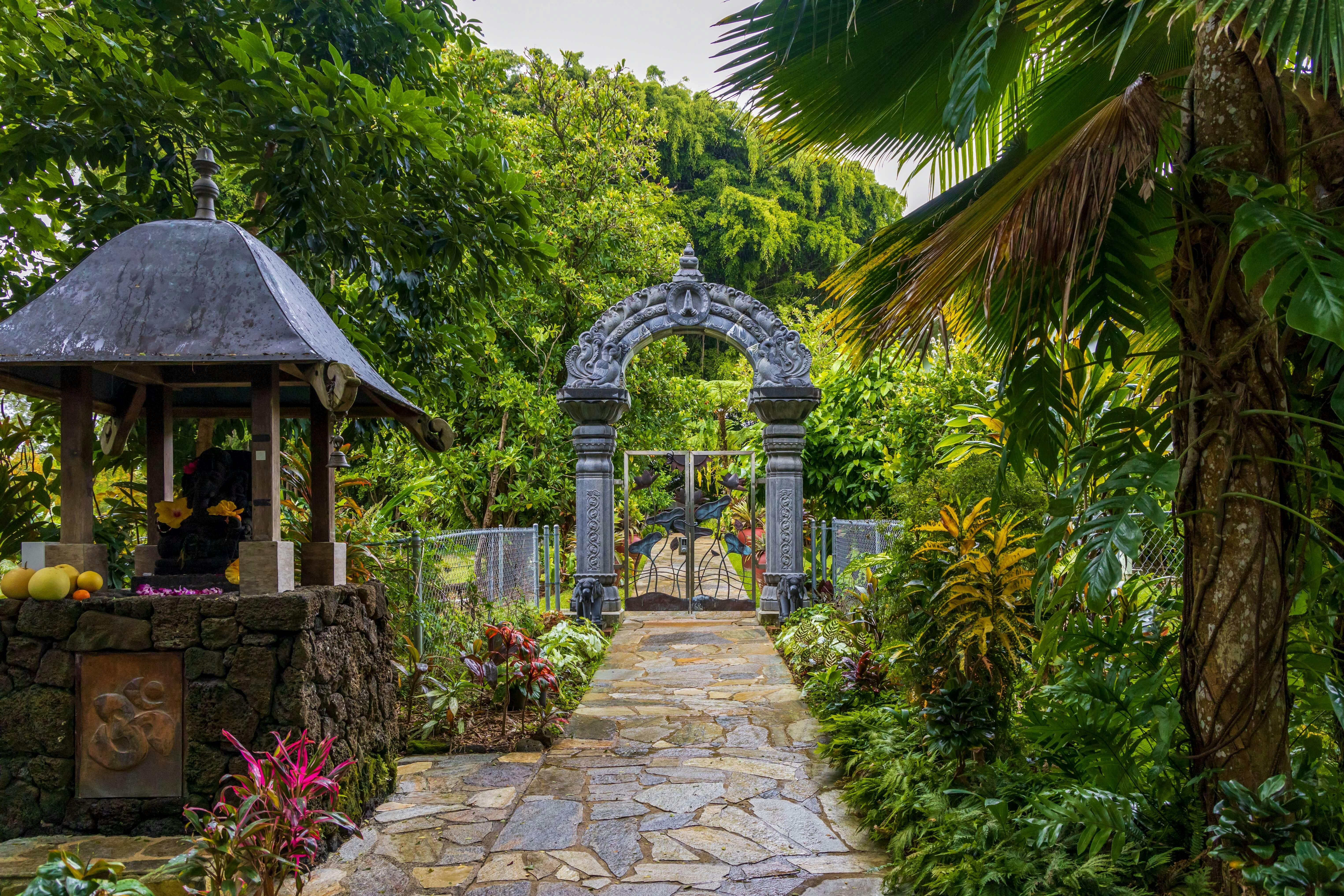
Wander a Hindu monastery
Rooted in the Hindu tradition of Sri Lanka and South India, Kauaʻi’s Hindu Monastery was founded in 1970, and its two traditional Saivite Hindu temples are located on 363 lush acres in Kapaʻa.
While you have to make reservations to worship or meditate inside the small Kadavul Temple, the monastery's beautiful front grounds – all the way up to the Wailua River lookout and archway – are open to the public from 9am to noon daily. You can wander the premises or meditate under the immense banyan tree; the monastery just asks that visitors dress in either traditional Hindu garb or modest clothing. That means no shorts, short dresses, tight-fitting yoga pants, T-shirts or tank tops. Polo shirts are OK.
Hit the Koloa Heritage Trail
Drive, walk or bike the Ka Ala Hele Waiwai Hoʻoilina o Kōloa, or the Koloa Heritage Trail, a self-guided 10-mile tour of the most important cultural, historical and geological sites in Koloa and Poʻipu.
Each of the 14 stops has a descriptive plaque explaining its significance. Some of the sites include Spouting Horn Park, a famous south shore blowhole; Makawehi and Paʻa dunes, a fossil bed that’s now a popular bird-watching spot; Koloa Jodo Mission, a Buddhist temple built in 1910, and the Sugar Monument, which commemorates the site of Hawaii’s first sugar mill. (Koloa is home to the first commercial sugar plantation in the state.)
Drive through the famous Tree Tunnel
You can’t visit Kauaʻi without driving through the famous Tree Tunnel, a 1-mile stretch of Maluhia Rd (Hwy 520) that heads south to Koloa and Poʻipu. The road is lined with hundreds of eucalyptus trees from Australia, creating a lush canopy more than 100ft tall. Drive slowly, or find a safe place to pull over if you want to snap a photo. Just don't hold up traffic or run into the street – it’s a well-trafficked road.

Lounge on a beach, any beach
Kauaʻi has some of the best beaches in the world – and for the most part, they’re free. (Exceptions are Haʻena and Kēʻē, which require advanced reservations and an entrance fee to Haʻena State Park.) Swim, snorkel, surf or just lounge with a good book on any of the island’s gorgeous golden sands, from picturesque Hanalei Bay on the north shore to perpetually sunny Poʻipu Beach on the southern.
If you like to snorkel and have your own equipment, visit Makua (aka Tunnels) Beach about 9 miles from Princeville, where the crystal-clear waters are teeming with marine life. Families can drive to the less crowded ʻAnini Beach, which is protected by a 2-mile-long reef that prevents large waves from rolling in. For sunset viewing, head to Polihale State Park, one of the largest beaches in Hawaii, where you can see parts of the Na Pali Coast.
Cross Hanapepe's Swinging Bridge
When you walk through charming Hanapepe – and you’ll want to! – you’ll notice an old swinging bridge connecting a small community and farms to the historic little town. For more than 100 years, this suspension bridge has spanned this part of the Hanapepe River, though it was damaged by Hurriane ʻIniki in 1992 and rebuilt in '96. It’s fun to cross – the bridge may not swing as much as it used to, but it still sways and makes for great Instagram photos.
Pay respects to a historic Hawaiian village
On the corner of Poʻipu and Hoʻowili roads sit the remnants of Kanei‘olouma, one of the only remaining historic Hawaiian villages on the island, dating back to the mid-1400s.
A 13-acre site containing taro patches, house sites, heiau and fishponds, it also features one of the only intact makahiki sporting arenas in the state. Makahiki was an ancient Hawaiian festival that began at the end of October and ran through February, honoring the god Lono. During this time war was prohibited and people celebrated by dancing hula, feasting and playing games, such as hōlua (sliding on sleds), hākōkō (wrestling), mokomoko (boxing) and ʻōʻō ihe (spear-throwing). The nonprofit Hui Mālama O Kāneiolouma is working to restore the site.
Enjoy the free show at Poʻipu Shopping Village
At 5pm every Monday and Thursday, Poʻipu Shopping Village offers free entertainment at its open-air shopping center. Enjoy live Hawaiian music and hula performances by dancers from the award-winning Hālau Ka Lei Mokihana o Leinaʻāla in the central courtyard.
You might also like:
Hawaii won't require booster for travel, explores ending Safe Travels restrictions
Accessible Hawaii: the best things to do for travelers with disabilities and additional needs
Hawaii's 20 most stunning views you have to see to believe: waterfalls, volcanoes and starry skies









